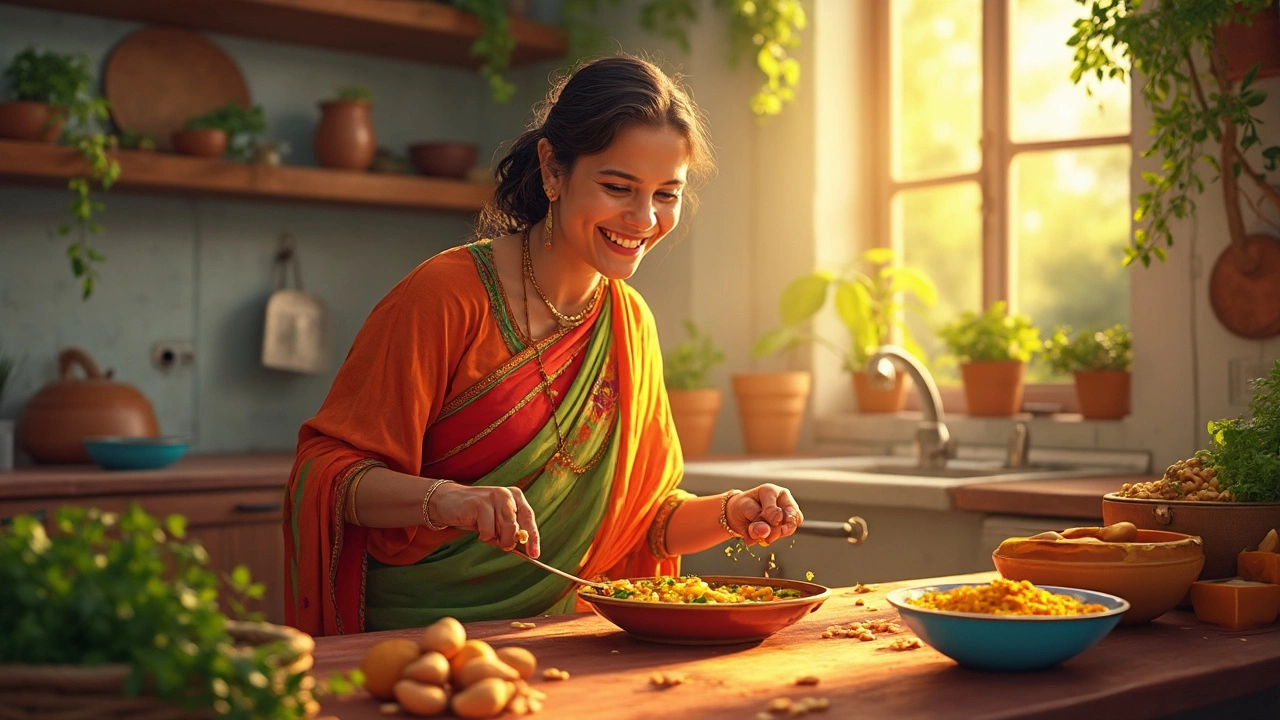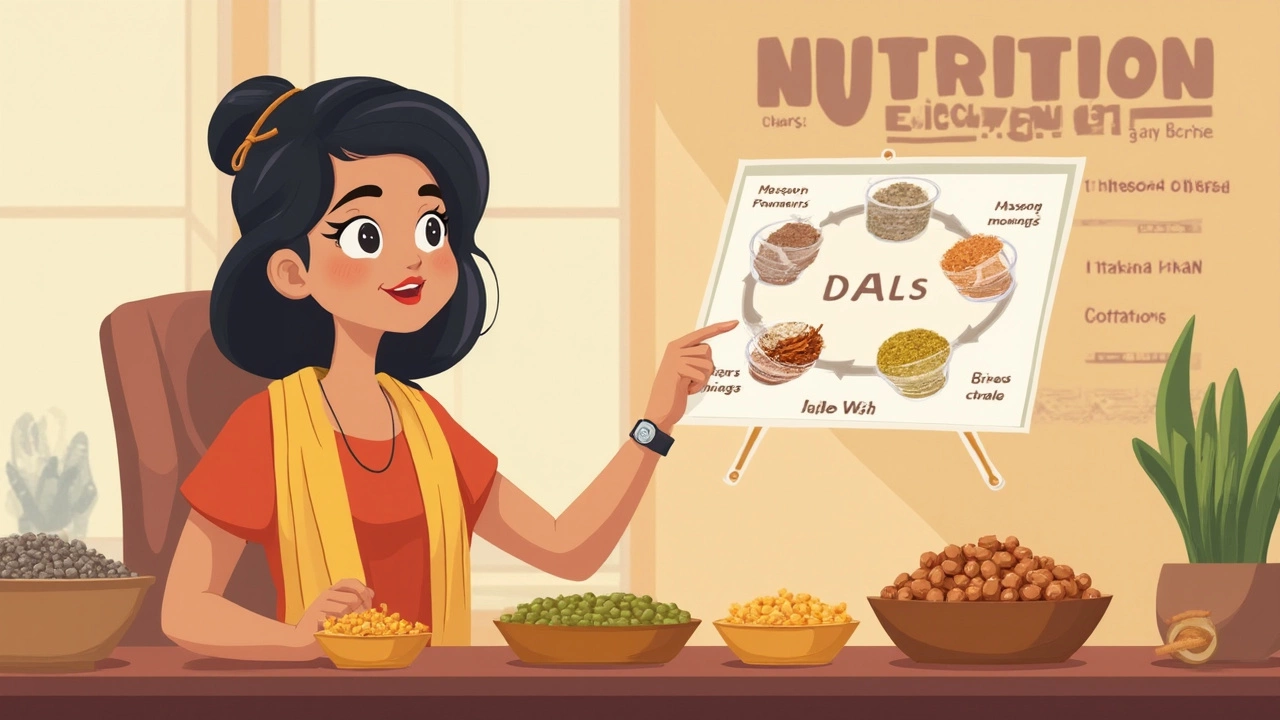Is Dal Healthy or Junk Food? The Real Scoop
 Jun, 22 2025
Jun, 22 2025
Ever wondered if that bowl of dal you make at home is actually good for you, or are you just eating junk in disguise? You're not the only one who's thought about this. A lot of people see dal as basic, but it turns out, there's way more going on in that yellow or brown mush than most folks realize.
Here's something most people miss: dal isn't just some comfort food you grew up on—it’s packed with protein, fiber, and a bunch of vitamins. Even if you're not a nutrition nerd, there are real reasons why dal pops up in so many Indian homes. And yet, walk into a restaurant, and suddenly dal feels heavy, creamy, and, well, maybe not so healthy anymore. What's the real deal?
The key is to look past just the recipe. What you put in your dal—like ghee, oil, or piles of cream—matters a lot. At home, you get to call the shots. Want something genuinely healthy? Go easy on the fat, skip the deep-fried tadka, and load up on veggies if you like. Dal can work for most diets, whether you're building muscle or just trying to eat light. Curious how to make yours even healthier? We’ll dig into practical tips and busted myths that can help you get the most out of every spoonful.
- What Exactly Is Dal?
- Nutritional Facts: Dal Under the Microscope
- Healthy or Junk: Where Does Dal Stand?
- Tips to Make Dal Even Better for You
- Common Mistakes That Turn Dal Into Junk
What Exactly Is Dal?
Let’s clear up what dal really is, because it’s not just a plate of mushy lentils. The word “dal” covers a big family of dried, split pulses—think lentils, peas, or beans. In India, you’ll see different kinds like moong, masoor, toor, chana, and urad dal. Each type has its own flavor, color, and texture. You just boil them, sometimes with spices and maybe a tadka (oil-tempered spices), to get the dish you know as dal.
You might hear nutrition experts rave about dal. Here’s how the Harvard T.H. Chan School of Public Health sums it up:
"Pulses such as lentils are rich in protein, fiber, and minerals, making them a valuable alternative to animal protein sources and an important part of a healthy diet."
Most packages just say “dal,” but if you check the ingredient list, you’ll spot the actual pulse. Here are some popular dal types and how they stack up:
| Type of Dal | Common Name | Key Nutrients (per 100g, cooked) |
|---|---|---|
| Toor Dal | Pigeon Pea | Protein 7g, Fiber 5g, Iron 1.3mg |
| Masoor Dal | Red Lentil | Protein 7.6g, Fiber 3.9g, Iron 1.5mg |
| Moong Dal | Yellow/Green Gram | Protein 7g, Fiber 8g, Iron 1.4mg |
| Chana Dal | Split Bengal Gram | Protein 8g, Fiber 7g, Iron 2mg |
What’s cool about dal is how basic it is. Water, heat, and a small handful of spices—that’s all you need. Some folks toss in tomatoes, onions, even greens or squash. Dal is like a clean slate for whatever flavor or texture you’re in the mood for.
And unlike meat, dal is cheap and keeps forever in the pantry. That makes it just as friendly for your wallet as it is for your body.
Nutritional Facts: Dal Under the Microscope
If you’re used to thinking of dal as just a carb fest, you’re missing the big picture. Dal is a powerhouse when it comes to plant protein and fiber, which is why it’s a staple for vegetarians in India and anywhere else where folks want something filling without meat. What’s wild is how much your bowl can actually cover your daily needs.
Take a look at this simple breakdown for one cup (about 200 grams cooked) of plain toor dal (split pigeon peas) without all the oily tadka:
| Nutrient | Amount per cup |
|---|---|
| Calories | ~190 |
| Protein | 14g |
| Fiber | 8g |
| Carbs | 35g |
| Fat | 1g |
| Iron | 3mg |
| Folate (Vitamin B9) | ~220mcg (over 50% RDA) |
| Potassium | ~370mg |
What’s important? Dal is loaded with protein compared to most other vegetarian options. It’ll keep you full way longer than plain rice. That fiber helps out your gut—not only for easy digestion, but also for keeping blood sugar from spiking fast. You probably didn’t know, but the iron in dal also adds up, which is super handy if you don’t eat a lot of red meat.
Here’s another cool bit: in countries like India, nutrition surveys show that over 70% of dietary protein for vegetarians comes straight from dal and other legumes. It isn’t all sunshine, though—a heavy load of dal alone won’t cover every single vitamin (it’s no substitute for veggies or fruits). But it does hit big marks for:
- Stabilizing blood sugar—because of the complex carbs and fiber
- Helping with weight goals—protein and fiber keep you fuller, longer
- Supporting muscle maintenance—especially if you work out
- Packing minerals like iron & potassium, plus a burst of B vitamins
If you’re watching calories, just pay attention to how much oil or ghee lands in your pot. Plain dal itself is pretty light, and most of the “unhealthy” part comes from what you add after cooking.

Healthy or Junk: Where Does Dal Stand?
Dal has a reputation as everyday food, but is it really healthy, or more like a comfort food that packs on calories? Let’s clear things up.
If you stick to simple home recipes—boiled dal, light tadka, not swimming in oil—dal is about as healthy as it gets. Get this: one cup of cooked dal has roughly 14 grams of protein and about 15 grams of dietary fiber. That means it keeps you feeling full, helps with muscle repair, and supports digestion. Not bad for something that costs less than a fancy coffee, right?
| Nutrient | Per 1 cup cooked dal |
|---|---|
| Calories | 230-250 |
| Protein | 13-15g |
| Fiber | 14-16g |
| Fat | Less than 1g (before adding oil/ghee) |
| Iron | 35% of daily needs |
| Folate | 90% of daily needs |
The catch? Dal can quickly switch sides if you dump in too much butter, ghee, or cream. That restaurant dal makhani you love? It might deliver your whole day’s worth of fat in one serving. And when dal gets paired with too much white rice or naan, you’re not getting the best nutrition bang for your buck.
- Homemade dal with little oil, lots of fresh spices and maybe some veggies = healthy.
- Dal loaded with heavy tadka and cream in restaurants = heading towards junk food territory.
- Bulk up your dal with spinach or pumpkin to boost nutrition without adding calories.
Want to make your dal even better for you? It’s simple—skip the extra fat, go heavy on flavor with onions, garlic, tomatoes, and even a squeeze of lemon at the end.
The bottom line: dal is healthy at its core, but it totally depends on how you cook it. Your kitchen, your rules. Just keep an eye on the add-ons and portion sizes, and dal easily wins as a smart healthy option.
Tips to Make Dal Even Better for You
Want your dal to pack a real health punch? It comes down to a few super simple tweaks you can use every day. Indian kitchens have done it for ages, but a lot of folks forget the basics when rushing through dinner. Here’s how you can get more nutrients and less regret from every batch:
- Skip the heavy fats: Instead of drowning your dal in ghee or butter, just use a teaspoon for the tadka. You’ll still get that great aroma without loading up on calories.
- Add veggies every time: Toss in spinach, carrots, tomatoes, or even zucchini. This boosts fiber, vitamins, and makes your meal more filling with almost zero effort.
- Balance the salt: Homemade dal can end up sodium-heavy if you’re not careful. Limit salt, and add flavor with cumin, coriander, garlic, and fresh herbs.
- Go easy on the cream: Some recipes call for fresh cream, especially in restaurant-style dal. At home, try curd or skip it altogether. The taste barely changes if your spices are on point.
- Soak your dal: Soaking lentils for a few hours or even overnight makes them cook faster and easier to digest. This simple habit can help if you’ve ever felt bloated after a meal.
Wondering what these tweaks mean for nutrition? Check out this comparison table for a basic idea of how changes add up:
| Dal Version | Calories/Bowl (150g) | Protein (g) | Fat (g) | Fiber (g) |
|---|---|---|---|---|
| Heavy Restaurant Dal | 220 | 7 | 10 | 3 |
| Basic Homemade Dal | 145 | 8 | 3 | 5 |
| Homemade Dal + Veggies | 155 | 9 | 3 | 7 |
One last tip—don’t rely only on white rice on the side. Mix it up with brown rice, millet, or quinoa to add more nutrition and curb that post-lunch crash. Try these tricks for a few weeks, and you’ll notice you feel lighter, less sluggish, and your wallet won’t complain, either.

Common Mistakes That Turn Dal Into Junk
You might think dal is healthy no matter what. But guess what? A few wrong moves can turn even the simplest dal into the kind of food your doctor warns you about. Here’s where most people mess up:
- Drowning it in Ghee or Oil: Sure, a bit of fat brings out flavors, but overdoing it means way more calories and can spike cholesterol. At home, one tablespoon of ghee has around 120 calories and 14g of fat. Imagine if you use two or three “just for taste.”
- Adding Too Much Cream or Butter: Some restaurant-style dal, like dal makhani, comes loaded with these. At home, skip heavy cream and use low-fat milk or just plain water for a creamy texture.
- Salting Without Measuring: It sneaks up on you. Too much sodium can raise your blood pressure and mess with your heart health. Try tasting as you go, and use herbs for flavor instead of a salt overload.
- Keeping It Watery or Oily: Restaurants might do this so they can serve more for less, but that means less actual dal and more liquid calories or fat. At home, aim for a thick, hearty pot with just enough oil to do the job.
- Using Pre-mixed Masalas: Many store-bought spice mixes are loaded with sodium, preservatives, and sometimes MSG. Make your own masala with fresh spices. It actually tastes better, too.
To see the numbers, here’s a quick look at how common mistakes change the healthy profile of dal:
| Dal Type | Fat (g) | Calories | Sodium (mg) |
|---|---|---|---|
| Basic home-cooked dal* (1 cup) | 3-5 | 190-220 | 200-300 |
| Restaurant dal (1 cup) | 12-18 | 350-480 | 700-900 |
*Based on 1 cup cooked with minimal oil, no cream, and measured salt.
Here’s a tip: measuring your ghee, using fresh spices, and limiting salt keeps your dal in the healthy zone. Oh, and don’t skip lentil rinsing—leftover residues or rocks don’t belong in your favorite bowl. Small changes make a big difference.
